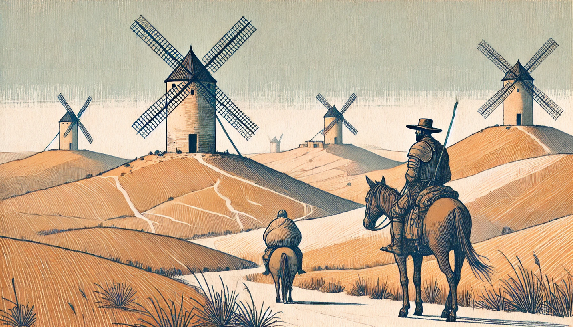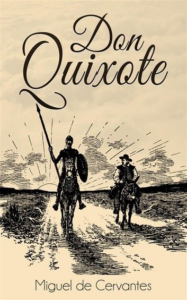SUMMARY
- Explores the tension between idealism and realism through the adventures of Don Quixote and his squire, Sancho Panza.
- Critiques chivalric literature and societal norms using satirical humour and philosophical reflection.
- Examines the complexities of human perception and how personal beliefs shape one’s understanding of reality.
- Investigates the blurred lines between madness and inspiration, highlighting the protagonist’s quest for purpose and heroism.
- Remains a timeless classic due to its blend of humour, adventure, and deep insights into the human condition.
REVIEW
Don Quixote, written by Miguel de Cervantes, is a seminal work in Western literature, often hailed as the first modern European novel. Published in two parts in 1605 and 1615, it tells the story of Alonso Quixano, an ageing nobleman who, inspired by tales of chivalry, decides to become a knight-errant under the name Don Quixote. Accompanied by his loyal squire, Sancho Panza, Quixote embarks on comedic misadventures, mistaking mundane situations for grand quests, such as his famous encounter with windmills he believes to be giants.
The book’s impact lies in exploring the tension between idealism and realism, as well as its commentary on human perception and the fine line between madness and inspiration. Cervantes uses satirical humour and philosophical reflection to critique chivalric literature and societal norms. This depth, combined with its humour and insightful portrayal of the human condition, has allowed Don Quixote to resonate with readers for centuries, offering a timeless exploration of humanity’s search for purpose and meaning.
Don Quixote explores the concept of idealism versus realism, portraying the protagonist’s romantic view of the world in stark contrast to the practical realities faced by his squire, Sancho Panza. This dynamic serves as a vehicle for Cervantes to explore the complexities of human perception, illustrating how personal beliefs and desires can shape one’s understanding of reality. The novel also examines the blurred lines between madness and inspiration, as Quixote’s seemingly irrational actions are driven by a deep-seated desire to live a life of purpose and heroism.
Additionally, the book offers a critique of societal expectations and the influence of literature on human behaviour. Through Quixote’s adventures, Cervantes questions the validity of chivalric ideals and the impact of romanticised narratives on individuals and society. This reflection on the power of stories and the nature of reality continues to captivate readers, making Don Quixote a profound exploration of the human experience.
What makes Don Quixote special is its ability to blend humour, adventure, and philosophical inquiry into a cohesive narrative that remains relevant across generations. Cervantes’s masterful storytelling and insightful commentary on the human condition have cemented the novel’s status as a timeless classic, offering readers a rich tapestry of themes and ideas to explore. Its enduring appeal lies in its capacity to entertain while provoking thought, making it a cornerstone of literary achievement.

CHARACTERS
Don Quixote: An ageing nobleman who becomes a self-styled knight-errant, driven by his obsession with chivalric tales.
Sancho Panza: Don Quixote’s loyal and pragmatic squire, who provides a grounded perspective amidst Quixote’s delusions.
Dulcinea del Toboso: A peasant woman, Don Quixote idealises as a noble lady, representing his unattainable dreams of love and chivalry.
Rocinante: Don Quixote’s old and feeble horse, symbolising his noble aspirations despite his physical limitations.
The Priest: A friend of Don Quixote who attempts to bring him back to reality and often critiques the absurdity of Quixote’s adventures.
The Barber: Another friend who, along with the Priest, seeks to help Don Quixote by intervening in his misguided quests.
The Duke and Duchess: Nobles who playfully manipulate Don Quixote and Sancho Panza for amusement, highlighting the absurdity of their adventures.
Cide Hamete Benengeli: Fictional Moorish author of the story within the story, representing the narrative’s self-awareness and commentary on storytelling.
The Knight of the White Moon: A character who challenges Don Quixote, representing the conflict between idealism and reality.
The Innkeeper: A figure who plays a significant role in Quixote’s adventures, often embodying the confusion between reality and Quixote’s fantasies.
LOCATIONS
La Mancha: The arid region where Don Quixote hails from, known for its windmills and vast plains.
Toledo: A historic city that serves as a backdrop for several of Quixote’s adventures, famous for its rich cultural heritage.
Barcelona: A vibrant city where Don Quixote encounters various characters and experiences, known for its artistic and architectural significance.
Sierra Morena: A mountain range where Quixote and Sancho Panza find themselves during their travels, symbolising the challenges of their journey.
Dulcinea del Toboso: The imaginary lady love of Don Quixote, representing his idealistic pursuits and chivalric fantasies.
Argamasilla de Alba: The village where Cervantes was imprisoned and where he is said to have begun writing Don Quixote, reflecting the author’s struggles.
The Inn: A recurring location in the novel where Quixote and Sancho Panza encounter various characters, often serving as a microcosm of society.
The Cave of Montesinos: A mystical cave that Quixote visits, symbolising the exploration of dreams and reality.
The Windmills: Iconic structures that Quixote famously mistakes for giants, representing the theme of illusion versus reality.
The Court of the Duke: A location where Quixote and Sancho Panza experience the absurdities of nobility, highlighting social satire in the narrative.
IMPROVES
- Creativity and Imagination: Reading Cervantes can inspire innovative thinking and enhance creative expression.
- Empathy: Engaging with diverse characters and situations fosters a deeper understanding of others’ experiences.
- Cultural Awareness: The book provides insights into historical and cultural contexts, enriching readers’ global perspectives.
- Emotional Intelligence: Exploring complex emotions in the narrative helps readers develop a better understanding of their emotions.
- Analytical Thinking: Analysing the themes and characters encourages critical thinking and deeper comprehension skills.
REFERENCES
- Book Review: Don Quixote by Miguel de Cervantes Saavedra – Books at True Story
- Don Quixote: A Satirical Critique of Knight Literature – Academy Publication
- Don Quixote by Miguel de Cervantes: A Review Essay – Academia.edu
- Multivalence and Relevance of the Myth of Don Quixote – Scholars International Journal
- Review: Don Quixote Volume I by Miguel de Cervantes – Bosphorus Review

